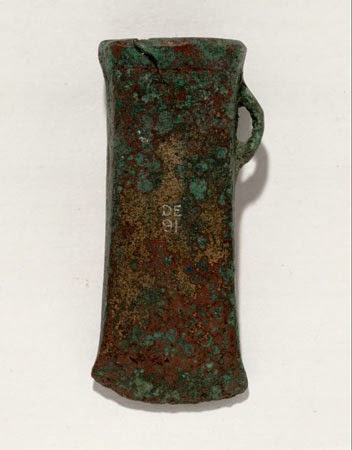The Bronze Age of Luffness
However, like most changes in culture and technology there is an overlap between the old Neolithic lifestyle and the brave new world of bronze. The period of prehistory when both stone and bronze implements were used is called the Chalcolithicii. This was a time when the prized objects that were fashioned in stone were now beginning to be cast in Bronze. We can see from the axehead find at Luffness (Table 1) that there was some continuity in the objects that the people of the new age valued.
| RCAHMS SITE NUMBER | LOCATION OF FIND | SITE TYPE |
| NT48SE 9 | Gullane | SOCKETED AXEHEAD (BRONZE)(BRONZE AGE) |
| NT48SE 24 | Gala Law | JEWELLERY (GOLD)(BRONZE AGE) |
| NT48SE 23 | Gala Law | FOOD VESSEL (BRONZE AGE) |
Table 1: The Bronze Age finds
The
miniature socketed bronze axehead (NT48SE 9) (illustration
1)iiiis
dated to the Bronze Age on the RCAHMS websiteiv
and described thus:
'A late Bronze Age socketed and looped axe, almost 2 1/2" long, and covered with a fine green patina was found in 1923, about 15' N of a probable Bronze Age burial in one of the sandy ravines E of Gullane (NT 48 82). It is now in the National Museum of Antiquities of Scotland [NMAS] (Accession no: DE 126).'.
However
on the National Museum of Scotland (NMS) website it is described as
dating from the Iron Age.
Illustration
1: These miniature axeheads, one of stone
and the other two of bronze, were found at Hawick in Roxburghshire,
at Blairbury in Wigtownshire and at Muirfield at Gullane in East
Lothian. They were probably used as amulets. Miniature polished
stone axe head, from Hawick, Roxburghshire. Axeheads were symbols of
power and prestige for a long period, probably with religious
significance as well. They were sometimes used as offerings to the
gods. Miniature examples were probably amulets, and remained popular
for thousands of years. Dates of axeheads, left to right: between
4000 and 1500 BC, between 950 and 750 BC, between 200 BC and 100 AD.
What
ever the date, this does show us that the axehead as a symbol or as a
tool continued through the Bronze Age. A couple of Bronze Age
axeheads were found on North Berwick Law and one is shown here
(illustration 2)v.
Illustration
2: This bronze axehead was found at North
Berwick Law in East Lothian. It dates from between 1150 and 950 BC.
The long narrow socketed axehead has an oblong mouth encircled by a
slight moulding. A wooden handle would have fitted into the
axehead's socket. A thong could also have attached the axehead to
the socket through the loop. Socketed axeheads appear to have been
invented on the Continent. They are part of a range of socketed
tools and swords made by smiths requiring more complex casting
techniques.
What does the new material and the objects tell us about the people and society of the Bronze Age?
Bronze
is an alloy of copper and tin which are not usually found together
but require the ingenuity of man to extract and combine them. To
produce the items that have been found in the Luffness area would
require often distant sources and technology, which dictated that
Scotland had to become part of an international network facilitating
the distribution of metal and other materialsvi.
Therefore,
we must have had a society that not only had miners and metullargists
but also a hierarchy who could purchase goods such as the gold
jewellery (NT48SE 24).
What
is also needed for the people of the coastal plain of eastern
Scotland is a form of commerce allowing them to purchase the items
made by the bronze 'industry'vii.
This was a period of dramatic social, economic, and cultural change,
characterised by changes in social stratification, rich regional
diversity and an increase in inter-regional, indeed international,
interaction, and development of the landscape.
It
has been suggested that the Bronze Age can be considered as a tunnel
into which the Neolithic cattle train disappears to emerge as two
millennia later as an iron horse. So, let us now exit the tunnel and
see the light of the Iron Age.
i
Scotland After the Ice Age: An Environment, Archaeology and
History 8000 BC - AD 1000:
Kevin J. Edwards, Ian B.
M.Ralston.
Edinburgh University Press,
2003; Page 8
iiThe
Consise Oxford Dictionary
iii
http://nms.scran.ac.uk/database/record.php?usi=000-100-032-872-C&scache=4a7ul64fo1&searchdb=scran&PHPSESSID=hnlkvlfb5sflvoga7p7bu2iga6
iv
http://canmore.rcahms.gov.uk/en/site/55084/details/gullane/
v
http://nms.scran.ac.uk/database/record.php?usi=000-100-104-703-C&scache=5byzr64fod&searchdb=scran&PHPSESSID=hnlkvlfb5sflvoga7p7bu2iga6
vi
http://tinyurl.com/clxgf5s
vii
The
New Penguin History of Scotland: From the Earliest Times to the
Present Day
edited by: R. A. Houston, W. W. J. Knox
London, Allen Lane, The Penguin Press in association with the National Museums of Scotland, 2001, ISBN: 9780713991871 Page 6.
edited by: R. A. Houston, W. W. J. Knox
London, Allen Lane, The Penguin Press in association with the National Museums of Scotland, 2001, ISBN: 9780713991871 Page 6.


No comments:
Post a Comment